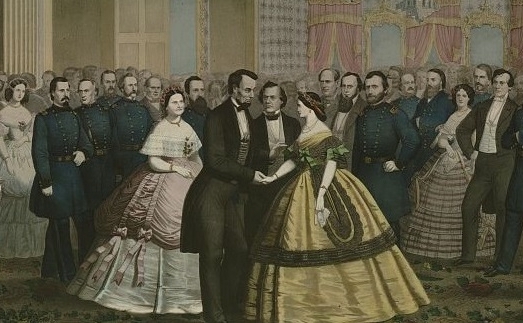The White House Years
In a popular Todd family story, young Mary tells politician Henry Clay she wishes she could live in the White House. When that wish came true, Mary Lincoln became one of the most controversial first ladies in history. Unlike some of her predecessors, she enjoyed public activities. But she also upheld the traditional roles of wife, mother, and—on a grand scale—homemaker. Throughout the White House years, her actions drew praise and criticism.
The Lincolns hosted numerous receptions, balls, and dinners in the White House. (Abraham Lincoln's Last Reception Courtesy of the Library of Congress)
The Lincolns moved into the Executive Mansion on March 4, 1861. Eager to impress the capital’s elite, Mary took on the job of refurbishing the dilapidated building. Newspapers covered her shopping trips and some Washington insiders frowned when she exceeded the Congressional appropriation for the project. Other observers praised the newly decorated White House.
Presidents were expected to entertain in war and peace, and Mary did so with gusto. The Lincolns greeted thousands of visitors at regular receptions and hosted concerts and other entertainments. Mary also helped plan large state dinners and less formal meals for small groups. Critics condemned her most famous event—a ball and supper for 600—as too extravagant for wartime.
The Civil War began within weeks of Lincoln’s inauguration, and Mary chose to remain in Washington, despite one general’s advice. She attended military demonstrations and visited army camps with her husband, volunteered in Union hospitals, and donated to sanitary fairs. She also supported the Contraband Relief Association, started by dressmaker Elizabeth Keckley, to help formerly enslaved men and women who had fled to Washington.
Sister Emilie Todd Helm visited the White House after her husband Benjamin Hardin Helm died serving in the Confederate army.
The divided Todd family also caused problems for Mary. Of her thirteen full and half siblings, eight supported the Confederacy. Accounts of a half brother’s abuse of Union captives in a Confederate prison and reports that a half sister smuggled goods from North to South reflected badly on the first lady. When Emilie Todd Helm—probably Mary’s favorite half sister—visited the White House after her husband’s death at Chickamauga, the president had to answer to a critical Union general.
Mary Lincoln lost other family members to the war. Her half brother Sam, a private in the Confederate army, died at the Battle of Shiloh. Alexander, another Confederate half brother, was killed in a friendly-fire incident. If Mary mourned, she did so privately. She later opposed her son Robert’s plan to join the Union army. But Robert prevailed, and the president found him a place on General Grant’s staff.
Mary’s resistance to Robert’s enlistment may have stemmed in part from losing another son. Willie and Tad Lincoln were ten and seven years old when they moved into the White House. Accounts of their antics abound, along with comments about their indulgent parents. Both boys contracted typhoid fever in 1862, and Willie died after several weeks of suffering. The Lincolns were heart-broken, but Mary expressed her grief more openly. Yet she soon returned to her duties as first lady.
Although she played a visible role in White House activities, Mary Lincoln’s involvement in the politics of the presidency was marginal. She was more active than many wives in her husband’s political rise. But as president, he was surrounded by male advisors, and Mary’s efforts to play politics sometimes got her into trouble.
During a carriage ride on April 14, 1865, the Lincolns made optimistic plans for the future. The assassination dashed those hopes. Overcome by grief, Mary Lincoln did not attend her husband’s funeral. She remained in the White House until May, when she moved to Chicago with sons Robert and Tad and began her life as a widow.
Learn more:


